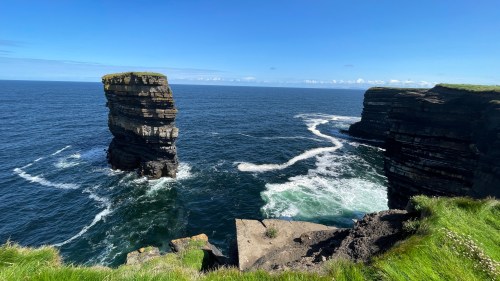Morning found a handful of us RVers huddled together, lost in a truly massive, mostly paved parking lot. We have come to the iconic Cliffs of Moher and we are huddled together because it’s the only semi level spot in the whole damn car park.
It’s overcast, gloomy, and rainy and any thoughts of hiking are laughable at this point. The situation is that it’s quite a hike just to get to the start of the hike. Eventually we deemed it passable and we gathered our resources if not our boots and trudged up to the interesting looking visitor center.

At the cliffs the path bifurcates and we chose the path to the right, up towards O’Brian’s Tower (1835), sitting like a crown on top of the hill.


As we descended the hill we had a great view of the cliffs as they wrap around the bay to the left.

The trail constantly rises, sometimes narrow, sometimes wider, but always relentlessly climbing.


I couldn’t help but notice they had moved the trail back from the cliff edge a disconcerting dozen feet or so.

Eventually we reached what felt like the high point, although it looks like one of those Irish hikes that continue on for many more miles along the coast.

Reluctantly we headed back down.

Footsore and tired, we made it back to Escape Velocity but there was no rest for your aimless wanderers and we had just enough time to make it to our next parkup.
What a jewel awaited us at this tiny car park.

We knew there would be some sort of ruin here but I never gave it much thought, thinking it’s probably closed anyway. Yeah, I know you’re thinking this is a possible rule #2 violation (Don’t get jaded.) But the more I studied this tower the more excited I became. And as it turns out, it’s open and free to explore.


Carrigafoyle Castle was constructed by Connor Laith O’Connor in the 1490’s on a large outcropping rock at the mouth of the Shannon. It was thought of as the Guardian of the Shannon due to its strong strategic location.

Other times the owners were thought of as the taxman because of their habit of sailing out to intercept shipping on its way up to Limerick and demanding a handsome percentage of the cargo. The ships were easily spotted from the 98 foot tall tower.

The unconventional choice of using flat slabs of flagstone was because in the 1490s it was thought to be impenetrable by the conventional weapons of the time.

Technology marches on and by 1580 during the Easter siege of the castle, the Brits had the answer and used high powered cannons. They fired from the hills behind the castle and blew that fearsome hole high in the tower which collapsed the wall, crushing most of the rebels beneath. Any survivors were dispatched as per the rules.

The double arches supporting the roof are probably the only reason the tower still stands.

It takes 104 steps up the spectacular spiral staircase to reach the atrium at the top.







The view from the top reminded us that our tendency to wander with no set destination sometimes brings surprising rewards. And it’s why we coddiwomple, travel for the sheer pleasure of the journey.



























































































































































































































